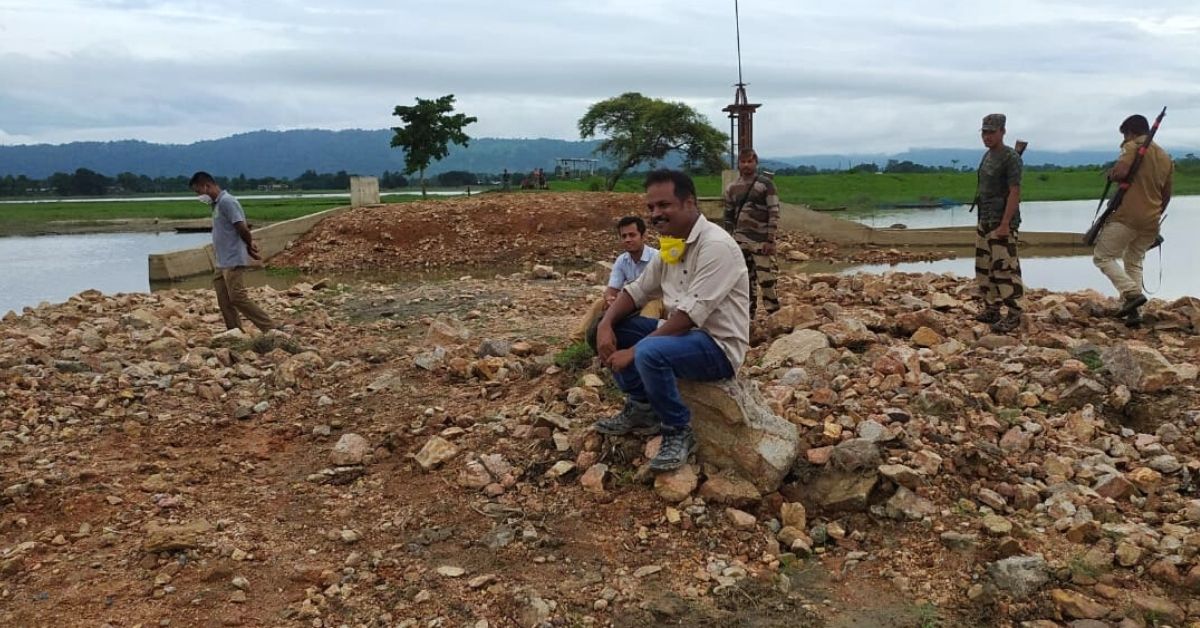IFS Officer Makes 6 New Wetlands in Kaziranga, Ensures Water For Rhinos, Elephants
P Sivakumar, field director at Kaziranga national park created six wetlands to help wildlife access water and reduce man-animal conflict

A crash of one-horned rhinoceroses or a herd of elephants bathing in ponds, and just a glimpse of a tiger, if one is lucky, are common sightings in the Kaziranga National Park in Assam.
This national park is home to two-thirds of rhinos in the world. Spread across an area of 430 sq km, the UNESCO world heritage site is a safe haven for wild buffaloes, deers and migratory birds like the lesser white-fronted goose, black-necked stork, Asian Openbill stork, Baer’s poached duck, among others.
To host thousands of animal populations and hundreds of species requires a lot of water and food. Despite having the Brahmaputra river flowing alongside this haven, there are 190 wetlands in the national park, but there is always a need for more.
Addressing these water issues, one forest officer at the helm of the national park restored and created additional wetlands for the animals.
Summer woes

“The issue faced here is that a little over 40% of the wetlands have sufficient water throughout the year. The other wetlands start drying up post December depending on the rains received the previous year, and, if they are delayed, the wildlife bears the brunt of the water shortage during March and April months,” says P Sivakumar, field director at the national park.
Moreover, some of the wetlands get silt accumulated in them during heavy monsoon rains, reducing their water carrying capacity. The sand in these water bodies negatively impacts the water retention capacity, too.
Sivakumar shares that much of the habitat from the central and southern part of the park has to move upwards in search of water. Apart from being time-consuming, it is a long journey for wildlife.
The animals often move to the hills of Kanchanjuri to areas in Jakhalabandha where the human settlements are located. No serious incidents reported as yet, the forest official admits that the search for water often leads to man-animal conflicts.
“It is not only the drinking water requirement that needs to be fulfilled but also wetlands serve as a habitat for animals like elephants, buffaloes, among others. So, the idea was conceived to create new habitats in the area,” the officer says.
New wetlands

The work started in 2019 when the authorities blocked the exit points of some wetlands located in Kohora, Bagori and Agoratoli wetlands to assist in rainwater harvesting and created a new wetland in Chirakhowa.
In 2020, additional wetlands in Potahi Beel, Bandardubi, Deosur, Haldibari and Potalchang were created.
“The wetlands are huge and serve as habitats. Some of them are earthen, whilst the remaining are permanent or seasonal wetlands as the floods can wash them away. Besides compensating for the shortage of water in other wetlands, the new water bodies also work as tourist spots as many animals are sighted from these prime locations,” Sivakumar says.
Speaking with The Better India, the officer adds that the protection and conservation of the habitat are primary objectives. Creating and improving habitat come at the advances stage. “The wetland creation is one step ahead of making the habitat safe,” he says.
Sivakumar says the future plans also include identifying new spots for more wetlands. “We are also in the process of identifying the increased water capacity through the new wetlands and measuring the water harvested each year. The scientific approach will help monitor and manage water in the national park,” he adds.
(Edited by Divya Sethu)
If you found our stories insightful, informative, or even just enjoyable, we invite you to consider making a voluntary payment to support the work we do at The Better India. Your contribution helps us continue producing quality content that educates, inspires, and drives positive change.
Choose one of the payment options below for your contribution-
By paying for the stories you value, you directly contribute to sustaining our efforts focused on making a difference in the world. Together, let’s ensure that impactful stories continue to be told and shared, enriching lives and communities alike.
Thank you for your support. Here are some frequently asked questions you might find helpful to know why you are contributing?


This story made me
-
97
-
121
-
89
-
167











